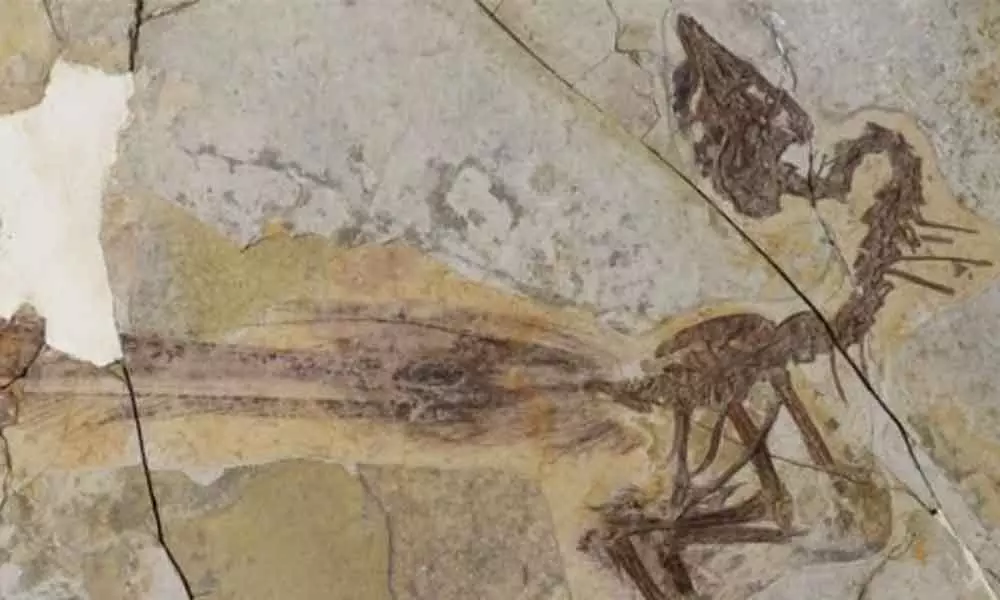120-Million-Year-Old Bird With An Inappropriate Tail Has Been Discovered In Fossil

A 120-million-year-old bird with a extremely impractical tail has been discovered in a spectacular fossil
- A 120-million-year-old bird with a extremely impractical tail has been discovered in a spectacular fossil.
- Yuanchuavis (Yuanchuavis kompsosoura), a phoenix-like bird in Chinese mythology, was discovered in northeastern China
A 120-million-year-old bird with a extremely impractical tail has been discovered in a spectacular fossil.
Many current birds trade agility for the potential to attract attention, although occurrences among relatives in the fossil record are rare.Scientists have described the remnants of a 120-million-year-old feathered dinosaur that was around the size of a bluejay and had an extraordinarily long and lavish back.
Yuanchuavis (Yuanchuavis kompsosoura), a phoenix-like bird in Chinese mythology, was discovered in northeastern China and given the name Yuanchuavis (Yuanchuavis kompsosoura).It's the first time a Mesozoic bird-like fossil with such a complex array of tail feathers has been unearthed, including both a grey fantail and a pair of long black plumes.The two long, dark feathers are almost 1.3 times the length of the bird's body, measuring 30 centimetres (12 inches), report published by Sciencealert.
The discovery shows that even the earliest birds were doing something similar with their feathers. However, there are certain drawbacks to being attractive. Flying and avoiding predators would have been much more difficult if Yuanchuavis had a tail as large and dazzling as theirs.
palaeontologist Jingmai O'Connor of Chicago's Field Museum, stated thatcharacteristic like a big showy tail is called a 'honest signal' by scientists since it is harmful, so if an animal with it can survive with that handicap, that's a sign that it's really fit.
Enantiornithes is a sister group to ornithuromorpha, which includes all living birds. Only one of these clades survived the great extinction catastrophe that wiped off most dinosaurs after coexisting for around 65 million years.
Understanding why one avian group survived while the other did not could help us better grasp how modern birds have managed to thrive in this planet.
The ancestors of contemporary birds did not appear to have lengthy tail ornaments like those found on Yuanchuavis in the Mesozoic epoch, however they do exhibit fan tails in the fossil record.
For long years, ornithuromorphs were thought to be the only animals with fan tails. However, multiple enantiornithes fossils have recently been discovered with this characteristic.Even stranger is Yuanchuavis. The combination of fantail and paired plumes on its tail is a trait present in no other bird in its lineage.
The authors aren't sure why Yuanchuavis evolved such a complicated tail, but considering how uncomfortable the feathers would have been in terms of aerodynamics, they believe sexual selection sculpted the plumages.There are several places to hide and run in a thickly forested habitat, where most enantiornithes are known to have lived. If the tail is attractive enough, it may not be that horrible. The majority of birds of paradise can now be found there.
The trade-off between sex and survival may not have been as advantageous in the more open, semi-aquatic settings where most ornithuromorphs thrived during the Mesozoic.
Because of the differences in landscapes, it's possible that enantiornithines evolved pintails before their sibling group.
Meanwhile, due to the imprecise nature of the fossil record, it is notoriously difficult to discern if a certain fossilised structure was sculpted by sexual selection. As a result, the well-preserved tail feathers of this unique fossil bird reveal a lot about how sexual selection has moulded avian tails from the beginning.
Next Story

















